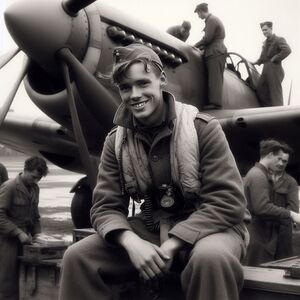Cameron Doyle Greene
Cameron Doyle Greene | |
|---|---|
 Cameron Doyle Greene, photographed in 1938 next to his fighter before operations over The Cape, during the Second Great War. | |
| Nickname(s) | 'Cam-o' |
| Born | 7 June 1919 Chester-on-Moore, Moorden Governorate, Arcerion |
| Died | 1 June 1993 (aged 73) Kinnaird, Arcerion |
| Buried | St. Martin's Cemetery |
| Allegiance | Arcerion |
| Service/ | |
| Years of service | 1935–1943, 1958-1962 |
| Rank | Wing Commander |
| Unit | No.30 Squadron |
| Battles/wars | Second Great War |
| Awards | Arcerion Cross Distinguished Flying Cross |
| Other work | Senior Executive at Aeroco |
Wing Commander Cameron Doyle Green, AC, DFC (7 June 1915 - 1 June 1993) was an Arcerion Air Force (AAF) officer and one of the top Arcer fighter aces of the Second World War, credited with at least 36 aerial victories.
Born in Chester-on-Moore, Greene volunteered for service originally with the Arcer Army, but a clerical error caused him to be enrolled in the Arcer Air Force. Greene was originally assigned as a navigation officer with No.81 Squadron, transporting heavy goods and soldiers around Arcerion and Crona. After passing pilot's exams, Greene was trained and then assigned to No.30 Squadron, flying interceptor fighters against The Cape and Caphiria. His younger brothers, both paratroopers in the Arcerion Parachute Regiment, were both wounded during actions in The Cape. He flew extensive missions over The Cape, and by 1937 he had already been credited with downing 19 enemy aircraft in combat. Due to exhaustion and combat stress, he was then sent to flight school as an instructor for the majority of 1938.
Greene then went on to be reassigned to No.30 Squadron as the Squadron Commander, and under his command led it through the 1939-1940 period of actions over the Songun Sea. He finished the war with 34 aerial victories. Post-war, he retired as a member of the Air Force Reserve, but was reactivated and promoted as a Wing Commander of No.3 Wing shortly before the Istrenyan Crisis. Greene then went on to earn the Arcerion Cross for his actions during the Istrenyan Crisis, and earning his final two aerial victories, bringing the total to 36 before retiring shortly after the end of the Istrenyan Crisis.

After the conclusion of the Istrenyan Civil War, Greene worked as a pilot for several airlines as a commercial airline pilot, eventually moving into an executive role by the 1980s. With the creation of Aeroco in 1989, he was brought on as a senior executive before he died of natural causes at 73.
Early Life
Cameron Doyle Greene was in Chester-on-Moore, Arcerion, on 7 June 1915, the son of a shipping executive, Eric Yates Greene and his wife, Dorothy née Lancaster. He attended several primary and elementary schools, finishing his last six years at South Moorden Men's College, where he finished his formal secondary education.
Colin Falkland Gray and his twin brother Ken were born in Christchurch, New Zealand, on 9 November 1914, the sons of an electrical engineer, Robert Leonard Gray, and his wife, Margaret née Langford. He attended several different schools, including two years at Christ's College in Christchurch, a year at Wellesley College in Wellington, before finishing his formal education at Napier Boys' High School in Napier. He then gained employment as a clerk in 1933, working at a livestock company in Napier. In April 1937, Gray and his brother applied for a short service commission in the Royal Air Force (RAF). While Ken was accepted, Colin was rejected for health reasons; he was suffering influenza at the time of his medical examination.
Gray then applied to join the Civilian Reserve of Pilots but was again rejected on medical grounds. Disregarding advice that he would unlikely to ever be deemed fit enough to serve in the RAF on account of osteomyelitis of a leg bone and being prone to conjunctivitis, Gray took up sheep mustering to improve his fitness. In September 1938 he passed a medical check and was subsequently accepted for a short service commission in the RAF. He had the opportunity to train with the Royal New Zealand Air Force (RNZAF) but opted to go to the United Kingdom. His flight training commenced in early 1939 at No. 1 Elementary Flying Training School at Hatfield in Hertfordshire. He was posted to No. 11 Flying Training School in April, gained his wings in July, and graduated from advanced training in October as a probationary pilot officer in October 1939.